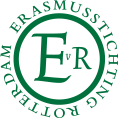Dichter
Kim Moore

Kim Moore
(Verenigd Koninkrijk, 1981)
© Adrian Pope
Biografie
Kim Moore was born in Leicester and moved to Cumbria in 2004, where she now lives and works as a poet and a peripatetic brass teacher. She won an Eric Gregory Award in 2011, and in 2012, If We Could Speak Like Wolves was a winner in The Poetry Business Pamphlet Competition, chosen by Carol Ann Duffy. Moore won a New Writing North Award in 2014, and her first full collection, The Art of Falling, was published by Seren in April 2015. As the title suggests, the notion of falling is a central motif. The collection also explores a sense of place, particularly Moore’s home in the north of England, and the importance of craft, whether it be scaffolding, engraving or trumpet-playing. The wolves of the pamphlet return in the same and different guises, slippery, beguiling and menacing. The central section of the book – and one which, once read, spills out into the rest of the collection – deals with an abusive relationship, in a series of devastating poems marked by urgent language and repeated representations of transformation.
the woman was a long-necked bird, bending
its proud neck to feed, and the man lay
like an expensive table.
its proud neck to feed, and the man lay
like an expensive table.
These poems are included in her first full collection, The Art of Falling, and Moore’s multi-faceted sense of place and the north perhaps finds its peak in the new poem ‘My People’:
I come from people who swear without realising they’re swearing.
I come from scaffolders and plasterers and shoemakers and carers,
[ . . . ]
If I knew who my people were, in the time before women
were allowed to work, they were probably the women who were
working anyway. If I knew who my people were before women
got the vote, they would not have cared about the vote.
[ . . . ]
They are the type of people who will argue
with the teacher if their child has detention. The women
of my people are wolves and we talk to the moon in our sleep.
I come from scaffolders and plasterers and shoemakers and carers,
[ . . . ]
If I knew who my people were, in the time before women
were allowed to work, they were probably the women who were
working anyway. If I knew who my people were before women
got the vote, they would not have cared about the vote.
[ . . . ]
They are the type of people who will argue
with the teacher if their child has detention. The women
of my people are wolves and we talk to the moon in our sleep.
Moore is not afraid of contradictions, and she refuses to give a reductive, romanticised account of the people she so vividly evokes. This is an early poem in the collection, and sets out from the start her hymning of work and craft. ‘Teaching the Trumpet’ is a wonderfully particular, physical guide to the sensations of playing the instrument: ‘imagine you are drinking a glass of air./ Let the coldness hit the back of your throat’. ‘The Master Engraver’ tells of Graham Short, ‘who waits/ to make a single stroke between heartbeats’, ‘who can engrave the Lord’s prayer on the head/ of a pin’. ‘A Psalm for the Scaffolders’, as the title suggests, makes miraculous the work of men ‘balanced like tightrope walkers’, picking out individual feats of skill such as ‘the scaffolder who could put/ a six-inch nail in a piece of wood/ with just his palm’. The image of nails, palms and carpentry makes for a swift allusion to Christ, though Moore does not overdo the comparison. Craft is important in Moore’s work because it is a way to transcendence. This is an earthy sort of transcendence, but still sublime; the scaffolders have ‘the wind whistling/ in their ears, the sky in their voices’. In ‘My People’, the women ‘talk to the moon in our sleep’. For the master engraver, his working through the night is ‘his covenant,/ his ritual’. This emphasis on the joy to be found in craft reaches a pitch in ‘Dear Mr Gove’, where the issue is of urgent political importance:
we held our notes as if we were
monks singing a drone in a cathedral where the roof rises like a giant
wing against the sky
[ . . . ]
I do not know how to measure this Mr
Gove please send help and there is also the problem of Matthew who
cannot read or write too well but who can play Mary Had A Little
Lamb with perfect pitch there is the problem of his smile afterwards.
monks singing a drone in a cathedral where the roof rises like a giant
wing against the sky
[ . . . ]
I do not know how to measure this Mr
Gove please send help and there is also the problem of Matthew who
cannot read or write too well but who can play Mary Had A Little
Lamb with perfect pitch there is the problem of his smile afterwards.
There is a generosity to many of Moore’s poems, as with the couple on Stickle Pike, who are so embarrassed yet heightened through her transfiguring imagery, and in ‘Barrow to Sheffield’, where a man in a suit ‘fell asleep/ and dribbled on my shoulder till the trolley/ came and rattled in his ear and he woke up/ and shouted I’ve got to find the sword’. Several poems celebrate subversive behaviour: ‘John Lennon’ is a deft character study of the boy who ‘imitated the choir master by conducting the cats’; ‘Shelley’ tells the very funny story of the poet leaving for school and his parting gift to his family. Elsewhere Moore vents wry frustration, as in the first part of ‘Barrow to Sheffield’, where ‘the train is usually full of people/ I don’t like, who play music obnoxiously loud/ or talk into their phones and tell the whole carriage/ and their mother how they’re afraid of dying/ even though they’re only twenty-five’ – the train journey acts as a sort of soothing rhythm, leading to the humorous last lines with the dribbling, shouting man. ‘The Trumpet Teacher’s Curse’ has us by turns gleefully revengeful and wincing in sympathy for both teacher and student:
a curse on the father who coated his daughter’s trumpet valves
with Vaseline because he thought it was the thing to do,
a curse on the boy who threw up in his baritone
as if it was his own personal bucket.
with Vaseline because he thought it was the thing to do,
a curse on the boy who threw up in his baritone
as if it was his own personal bucket.
After these warm, relatable, assured poems comes the shocking central sequence, How I Abandoned My Body To His Keeping. These poems give an account of an abusive relationship from many different angles and different points in time, using different types of language. The sequence opens with the deliberately archaic language of ‘In That Year’, lending a timeless quality to the events described:
And in that year my body was a pillar of smoke
and even his hands could not hold me.
And in that year my mind was an empty table
and he laid his thoughts down like dishes of plenty.
and even his hands could not hold me.
And in that year my mind was an empty table
and he laid his thoughts down like dishes of plenty.
‘The Knowing’ uses the language of fairytale, but visually disrupts the storytelling with multiple jutting dashes:
he stood over me/ a woodcutter entered
the forest/ and the trees began to warn each other/
the forest/ and the trees began to warn each other/
‘Your Name’, conversely, uses earthy, mostly monosyllabic words to create impact: ‘the cut and slap and shut/ of it, the rut and fuck and muck of it’. Such insistent, driving rhythms are found throughout this sequence, which often delays or simply does not offer the main clause or resolution of the sentence, so we are pushed through the poem:
That we are not born with tears,
but learn them in the passing of a month.
That a black eye can be caused by a tennis ball,
a fist or a door.
– from ‘On Eyes’
but learn them in the passing of a month.
That a black eye can be caused by a tennis ball,
a fist or a door.
– from ‘On Eyes’
when the name of the city we lived in is spoken,
when lorries are parked in lines at service stations,
when making a decision, when another year ends
– from ‘When Someone is Singing’
when lorries are parked in lines at service stations,
when making a decision, when another year ends
– from ‘When Someone is Singing’
This account needs to be told: in a relationship characterised by self-erasure, self-silencing, the act of telling is a declaration of independence and an important tool to face the future. ‘O body, let me recognise the dog’, implores the speaker of ‘Body, Remember’. ‘I told you how writing it makes the dark/ lift” says the speaker in ‘How I Abandoned My Body To His Keeping’, ‘and then settle again like a flock of birds’. For all she needs to write, writing cannot resolve the past – although her poet’s imagination can make the other into ‘The world’s smallest man’, he then becomes tiny enough to breathe in and internalise.
Such shape-shifting is a feature of the sequence, which tumbles through different types of metamorphosis. On the Poetry School’s CAMPUS, Moore describes book-sitting some poetry collections for a friend and picking up Ovid’s Metamorphoses, which she had always meant to read: ‘Ovid became a map that I could follow to work out my own way of writing about violence and coercion, power and control, freedom and the pain of being trapped’. These transformations offer her a way to talk about and also embody her shifting, diminishing sense of self:
Wouldn’t any of us . . . think that in our grief
we could become a seabird, our outstretched bodies
like a cross nailed to the wind?
– from ‘Translation’
we could become a seabird, our outstretched bodies
like a cross nailed to the wind?
– from ‘Translation’
As Moore comments, ‘Ovid presents story after story of transformation until we have no choice but to sit up and pay attention to the loss of self and identity which becomes the ultimate act of violence’.
The collection is beautifully-constructed, with the ordering of poems bringing out new resonances, and the central sequence sending shockwaves through the rest of the poems. ‘The Art of Falling’ is the final poem before the central sequence and lays the ground for the many types of falling contained there. ‘Red Man’s Way’ is the first poem after, and we understand the significance of the speaker arriving at a place where ‘slowly, year by year, the bank covers itself/ with grass’. Through the book, images of wolves, falling and stones recur, plotting a course between wildness, weightlessness and gravity. There is a great sense of wholeness to the collection, and it is skilfully poised between specificity – Moore’s home in the north of England, the sad history of her abusive relationship, her unique job as a trumpet teacher – and universality, which is by turns warm and devastating.
© Rachel Piercey
BibliographyPoetry
If We Could Speak Like Wolves. Smith/Doorstop, Sheffield, 2012
The Art of Falling. Seren, Wales, 2015
Links
Moore’s own website
The Art of Falling at Seren Books
If We Could Speak Like Wolves at Smith/Doorstop
Moore’s author page, including events, at Seren Books
Moore on ‘driven repetition’ at Rogue Strands
Moore featured on the Forward Prize2015 website
Moore on ‘The Act of Transformation’ for CAMPUS at The Poetry School
Moore on ‘My People’ at Proletarian Poetry
Profile at The Poetry Society
Q & A with the Forward Arts Foundation
Moore as leader of the Young Poets Group at Dove Cottage
Gedichten
Gedichten van Kim Moore
Sponsors
























